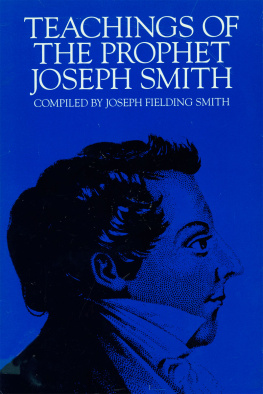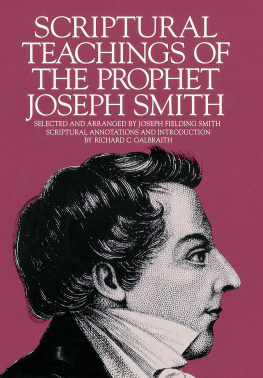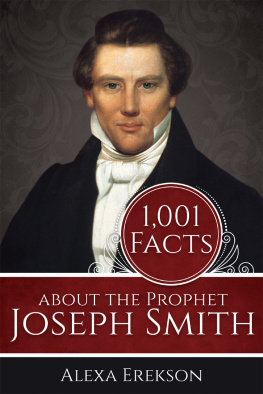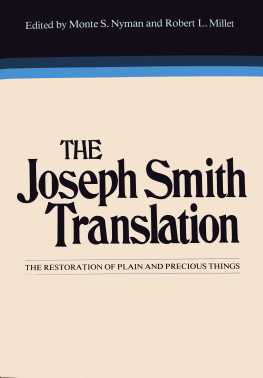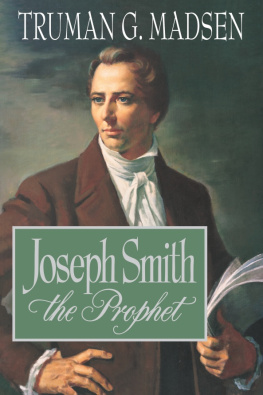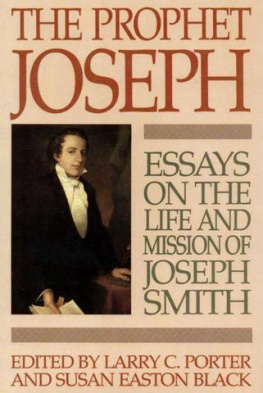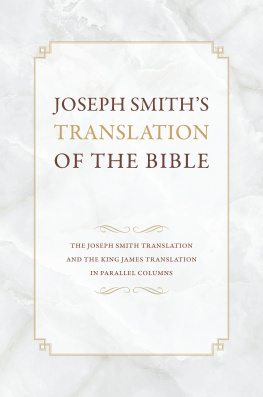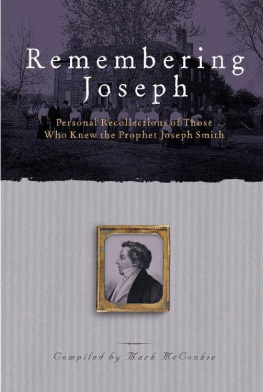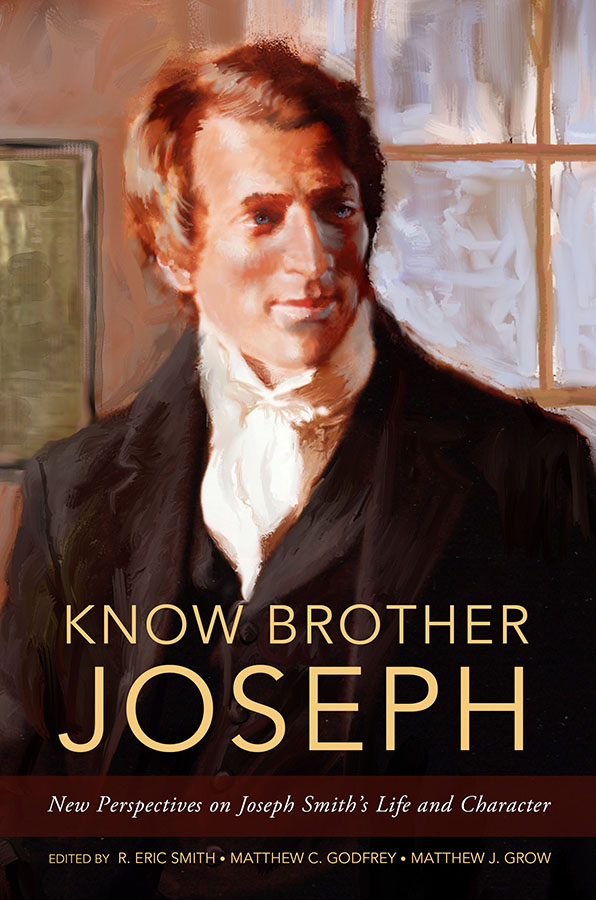Cover illustration, Joseph Smith the Prophet Glen Hopkinson. Used by permission.
Design by Shauna Gibby.
Book design Deseret Book Company.
2021 Robert Eric Smith, Matthew Charles Godfrey, and Matthew Joseph Grow
All rights reserved. No part of this book may be reproduced in any form or by any means without permission in writing from the publisher, Deseret Book Company, at permissions@deseretbook
.com or PO Box 30178, Salt Lake City, Utah 84130. This work is not an official publication of The Church of Jesus Christ of Latter-day Saints. The views expressed herein are the responsibility of the authors and do not necessarily represent the position of the Church or of Deseret Book Company.
Deseret Book is a registered trademark of Deseret Book Company.
Visit us at deseretbook.com
Library of Congress Cataloging-in-Publication Data
Names: Smith, R. Eric, editor. | Godfrey, Matthew C., editor. | Grow, Matthew J., editor.
Title: Know Brother Joseph : new perspectives on Joseph Smiths life and character / R. Eric Smith, Matthew C. Godfrey, Matthew J. Grow.
Description: Salt Lake City, Utah : Deseret Book, 2021. | Includes bibliographical references and index. | Summary: An anthology of history essays from leading scholars on the life of the Prophet Joseph SmithProvided by publisher.
Identifiers: LCCN 2020043856 | ISBN 9781629728742 (hardback) | eISBN 9781649330406 (ebook)
Subjects: LCSH: Smith, Joseph, Jr., 18051844. | Mormon ChurchPresidentsBiography. | LCGFT: Biographies.
Classification: LCC BX8695.S6 K56 2021 | DDC 289.3092 [B]dc23
LC record available at https://lccn.loc.gov/2020043856
Printed in the United States of America
PubLitho, Draper, UT
10 9 8 7 6 5 4 3 2 1
Contents

Preface
When the angel Moroni first visited Joseph Smith in 1823, he said that Josephs name would be known for good and evil throughout the world. Moronis statement has never been more true than in the present. Around the globe, millions of members of The Church of Jesus Christ of Latter-day Saints testify that Joseph was a prophet of God who restored Christs Church. As we write this in April 2020, the Church just completed a general conference that celebrated the Restoration. During this conference, the First Presidency and Quorum of the Twelve Apostles released a Bicentennial Proclamation to the World that shared their solemn witness of Josephs role in the restoration of the fulness of the gospel of Jesus Christ.
But, if indications on the internet can be believed, Josephs name evokes instant controversy among others who dismiss him as a fraud. A middle ground also exists: those who are curious and want to understand the phenomenon of a nineteenth-century American prophet. This middle ground also has more adherents than ever before; college classes around the world now include Joseph and the early Latter-day Saints in a variety of contexts.
Major historical figures must be understood anew by each generation, who bring new questions and demand fresh perspectives. These ongoing reassessments are most useful when based upon new information that can lead to enhanced understanding. The study of Joseph Smith at this moment benefits from such an increase in information, thanks largely to the Joseph Smith Papers. For the past decade, the three of us have been privileged to work with many other dedicated and talented historians and editors in compiling and publishing all of Josephs records.
While most of the documents being published in the Joseph Smith Papers have long been known by historians, publishing them together with the highest professional standards of historical documentary editing has yielded new perspectives on nearly every aspect of Josephs life. When completed in 2023, the Joseph Smith Papers will contain more than two dozen volumes, perhaps 20,000 published pages. In addition, if measured by the same standard, the Joseph Smith Papers website would add many thousands of pages of material not found in the print edition.
The sheer volume and complexity of the papers makes reading them a daunting prospect even for Latter-day Saints with a deep interest in Joseph. The core of this problem is that the Joseph Smith Papers are intended for scholars. The meticulous presentation of documents, the extensive footnotes, the in-depth introductions, even the size and weight of the volumesall of these indicate that these are substantial volumes that demand to be taken seriously by anyone researching Joseph. For Latter-day Saints, it can be difficult to wade through the volumes and synthesize the new information. Indeed, it will take a generation (likely more!) of scholars, believers, and detractors to digest and analyze this material.
This book is an attempt to bring insights drawn from the Joseph Smith Papersand other reputable sources about Joseph and the early Churchto a broader audience. We asked over forty individuals who have studied Joseph to write brief essays. The authors come from a variety of backgroundsmany are historians, while others are editors, writers, and teachers. We envision the result as something like a college course on Joseph and the early Church, with a different professor each day. Most academics are used to writing articles of thirty or forty pages, usually more than 10,000 words. Here, we asked each author to teach about Joseph using only about 1,500 words. Writing concisely, in a format intended for a broader audience, leads hopefully to a focused and accessible approach. We also asked the authors to consider how studying Josephs life and papers has influenced their own lives.
Weve spent the past decade reading Josephs mail, scrutinizing his journal, studying his revelations, puzzling over his legal and financial worlds. We have listened to the thoughts of his friends and pondered the words of his enemies. We have followed him seemingly every step from the Palmyra of his youth to Carthage. We are among the small group of individuals who have read every word in the Joseph Smith Papers print editionmost of them many times! For us, it is a great privilege to spend our professional lives with Joseph.
Through our work, we have been able to get to know Joseph as a human beingnot as a mythic figure. We have been with him in his triumphs and his failures, his joys and his sorrows. Knowing him as a person has given us even more appreciation for him as a prophet, for how the Lord used him as the instrument to restore the gospel of Jesus Christ. We hope that in these pages, you will also gain new insights into and appreciation for Brother Joseph.
Millions Shall Know Brother Joseph
By LeGrand R. Curtis Jr.
In April 1830, when The Church of Jesus Christ of Latter-day Saints was organized, William W. Phelps was a 38-year-old editor and publisher of the Ontario Phoenix in Ontario, New York. That year, he obtained a copy of the Book of Mormon and received a testimony of its truthfulness. Within less than a year he moved to Kirtland, Ohio, and was baptized and ordained to the Melchizedek Priesthood.
In 1836 he returned to Missouri, where he continued his duties as a leader of the Church. However, he was excommunicated in March 1838 due to actions he and some other Church leaders had taken. Phelps was reconciled with the Church but soon became estranged again during the persecutions against the Church in Missouri. His bitterness led him to testify against Joseph Smith in 1838, contributing to Josephs arrest, imprisonment, and suffering. Phelps was excommunicated again in March 1839.


